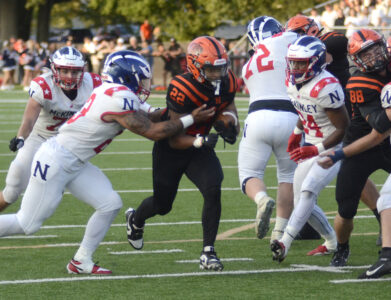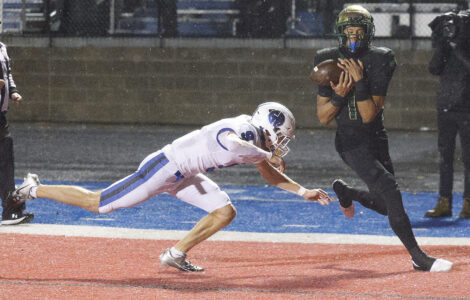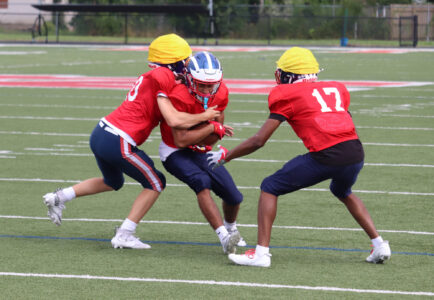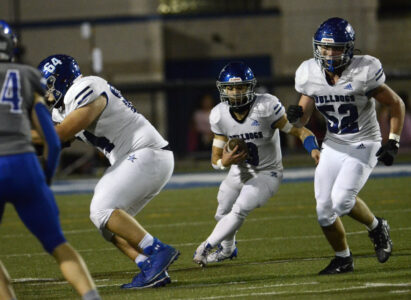Often overlooked, O-linemen form the bedrock for their programs
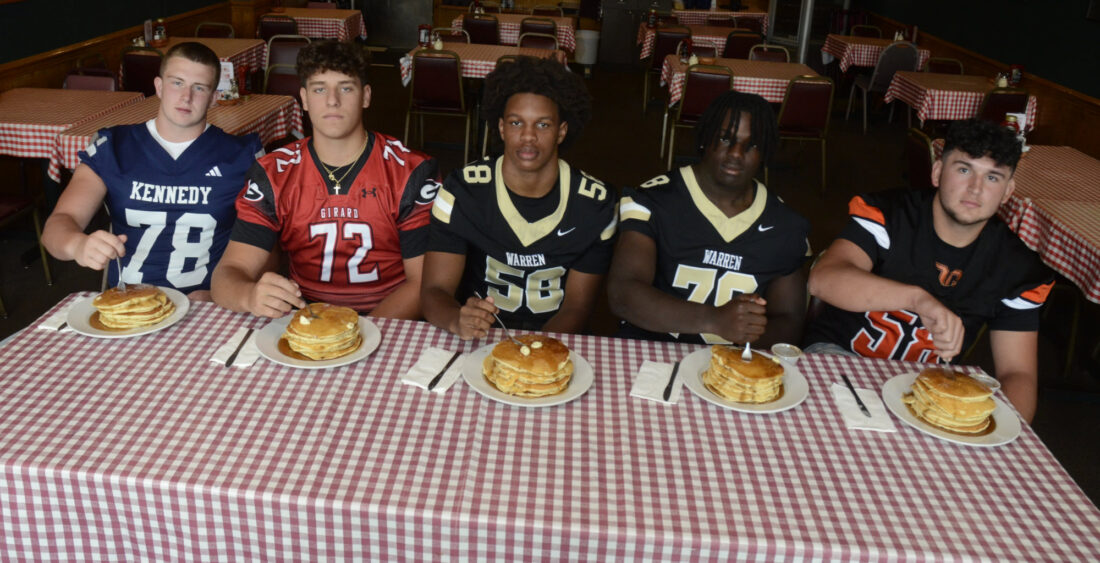
Staff photo / R. Michael Semple Trumbull County offensive linemen, including from left-to-right: Warren JFK’s Carter DeJulia, Girard’s Dylan Latell, Warren G. Harding’s Zayvion Smith and Ellis Daniels and Mineral Ridge’s Chase Moore pose for photos with their pancakes at Sunrise Inn on Aug. 5 in downtown Warren.
One day, near the end of his first season as a high school football head coach, Greg Lazzari fielded a call from the mother of one of his players.
Lazzari, in the midst of preparing for senior night later that week, answered, having no clue what the parent might want from him.
“Hey, coach,” the mother said. “He’s really enjoyed starting for you. He’s been doing all this and doing all that, but you could just make his season if he could just catch one pass.”
“Ma’am,” Lazzari responded, “your son’s a guard.”
Anonymity is at the heart of the offensive line. The spotlight is rarely ever on them — unless they make a mistake too obvious to ignore.
“You don’t get any recognition. You’ll never get your names in the paper. No one cares how many blocks you got,” Girard offensive line coach J.D. Latell said.
The absence of acclaim both attracts and creates a ‘different’ type of person, but how different and in what ways has changed.
“They’re thinkers. Where when I played, or even when I started coaching, kids weren’t asked to think, they were just told to do,” Warren G. Harding offensive line coach Bob Toth said. “You have to be willing to explain things more to them, instead of just telling them to do it, because they want to know why they’re doing it.”
Some are, more or less, forced into the trade. They’re too big, too slow or too strong to play anywhere else. Others were always meant to do it.
J.D. Latell, who described himself as a “bigger kid” in his playing days, followed in the footsteps of his uncle, a tight end — “they used to have them in our day” — who tutored Latell, an accomplished player at Girard before he attended the University of Findlay, where he was a part of the Oilers’ 1997 NAIA national championship team.
Now, J.D. is tutoring his own son, Dylan, a Girard junior who could safely be regarded as a “bigger kid,” too. At 6-foot-7, 310 pounds, Dylan Latell, naturally, has been a lineman ever since he began playing football.
“Dylan’s been with me here at the football stadium since he could walk,” J.D. Latell said. “He’s always been coming to practices with us. He’s been watching me and learning and always doing the steps.”
And, as any offensive line coach will say, there are a lot of steps.
Latell, Toth and Lazzari all agree that it takes a tremendous and underrated amount of mental acuity to play O-line.
“The biggest misconception that I think that people don’t appreciate is the intelligence required to play offensive line,” said Lazzari, now the Harding offensive coordinator, who began his career coaching offensive line. “Whether it’s a zone scheme or a gap scheme, those guys have to be able to recognize the front, they have to communicate who they’re blocking with, and they have to be able to get all five guys on the same page at the same time.
“People think, ‘Hey, they’re just running into each other.’ Well, yeah, we are running into each other, but we’re running into the correct guy at the correct angle with the correct knee bend and hand placement — all at the same time — just so the back can get through… And that doesn’t even include the passing game. What happens when the defense moves and the defense shifts? All week long, we practiced for this front, and boom, they jumped into a different one. They have to adjust, and they have to trust their rules. So the intelligence of offensive linemen is something I think that is really slept on.”
J.D. Latell said that the offensive line, along with the quarterback, essentially “run the team.”
Toth added that O-linemen do not, at least anymore, fit into the stereotype of “big, dumb and slow” because the position — or what is required of the position — has changed.
“You can’t be any of those three and be successful,” Toth said.
“You have to be able to move because of the way teams have changed over the years,” he added. “At one point in time, teams were sitting in a four-man front or five-man front. Now, that’s not the case. Defensively, everybody is getting upfield, and they’re angling with their D-linemen and those types of things. So you have to have quickness, you have to have athletic ability, and at the same time, you still have to be physical, and you have to be tough.”
What makes an offensive line successful, though?
The measurement of success for offensive linemen is radically different than most positions. Passing yards are shared by the quarterback and receiver. Rushing yards are owned by the ball carrier. On the defensive side, sacks, tackles, fumbles and interceptions are all credited to individual players, even their linemen counterparts.
For most teams, the O-line’s success is measured by the team’s success.
“I always tell guys when they talk about their teams, and all these people going to all these 7-on-7s and having success, that it’s all fun and games until the front gets involved,” Harding head coach Matt Richardson said. “That’s how far you’re going to go. Your team’s going to survive and advance as far as your offensive and defensive line [can take you].”
Building and maintaining a strong offensive line is far from easy, however.
It is, by most coaches’ admission, not a glamorous nor particularly simple position. Additionally, while there are technically five parts of the line, they have to work together as one cohesive unit.
“If one breaks down, they all break down,” Lazzari said.
For that reason, offensive linemen are rarely ever separated from one another. While coaches may sometimes take tackles and blocking tight ends aside while centers and guards practice together, they are never too far from one another.
“We’ll be in individual, we’ll be in group, we’ll be in group pass, we’ll be in all those things. And it’s normally an hour before we see anybody else,” Toth said.
The bond, as a result, can be formed quickly.
In July, Ellis Daniels, the son of LeShun Daniels Sr. and younger brother of LeShun Daniels Jr. and James Daniels, all Harding graduates, announced he was transferring from North Point High School in Maryland to Harding. It did not take long for him to feel at home.
“It’s been amazing. Just meeting these guys, it feels like I have a true connection with them,” Ellis Daniels said. “Even practicing with these guys, they feel like my brothers, other than my actual family.”
The unsung nature of the job, the collective hardship they face and the inherent teamwork required produce the unique bond linemen typically forge with one another, one that often dictates the success and failure of a team.
“They hang together because they know what they’re going through,” J.D. Latell said. “The skill kids are running around, catching balls, taking handoffs, and they’re pushing the sled in 90-degree heat. They’re staying under the chute while skill guys are making fancy cuts. So they appreciate what they go through. Therefore, I think that brings them together.
“It’s that trust that they have in each other that they become, in essence, like the best friends with each other on the team. They have each other’s backs, and they know that about each other, and that brings them together, and it makes it a great group of guys to coach.”

